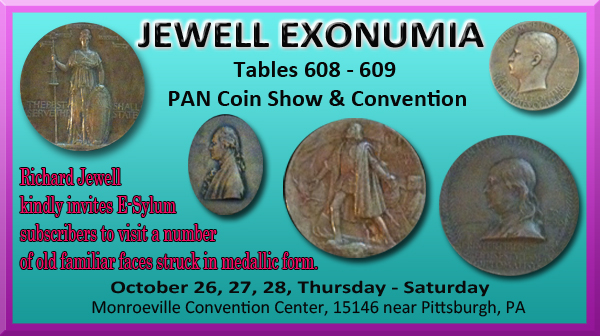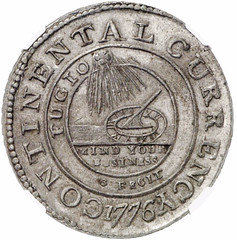
PREV ARTICLE
NEXT ARTICLE
FULL ISSUE
PREV FULL ISSUE
ONGOING THOUGHTS ON THE CONTINENTAL DOLLARWe've had a very interesting series of articles in the last few weeks relating to the origins of the Continental Dollar coinage. There have been questions on whether the
1776-dated pieces were actually coined in that year, whether they were ever a circulating coinage or whether they were authorized by or even known to the American Congress. Some evidence points to
their manufacture in England some years after 1776. Evidence on either side of the issue is scant. Here are some further comments from readers. -Editor
Bob Leonard writes:
Consequently, I have changed my mind about the Continental Dollar, and now think that THE WHOLE ISSUE was struck in England in 1783, dated 1776. Everything points in that direction. To confirm this, let's see whether we can identify the newspaper that the ad was cut from. And was there an engraver with the initials E G in London then? It would be worth combing the literature record for examples of common usage of the phrase "pewter dollar". Here's one I found with a cursory search (italics mine).
-Editor
"Silver is essential to a real dollar. If there is no silver in the seeming dollar, it is not a real dollar, but a counterfeit one." "A pewter dollar, with a good stamp, and well washed over, is a real dollar, or it is not; if it is a real dollar, then silver is not essential to a real dollar." For context, see: Maureen Levine adds these notes. Thanks! -Editor
Since I returned from a trip to Scotland, I’ve been following the Continental dollar thread that began last month. Below are some thoughts, with more to come at a later date. First, regarding the Eagleton article, those who are unaware of David Fanning’s astute analysis from the June 14, 2015, E-Sylum would do well to read it. In part, it says: More serious objections to Eagleton’s argument arise from two factual errors. First, she mistakenly states that the paper money design on which the Continental dollar dies were based is signed by E.G. (generally taken to be Elisha Gallaudet): “if this was meant to be a medal ‘representing’ the paper money, the presence on the Continental dollar of Gallaudet’s design and initials might not indicate any direct connection between him and the cutting of its dies. ... It might equally be a case of the die--sinker copying the design from the paper money faithfully in all details, including its errors, and also reproducing the signature of the engraver responsible for the printing plates from which the paper money had been made.” (page 298) In fact, only the metallic dollar is so signed: the paper money is not. This is a fairly serious lapse. A second serious lapse comes in Eagleton’s analysis of the printed advertisement. She clearly writes on page 298 that “the advertisement states that they were minted in Europe.” It does no such thing. There is absolutely nothing said in the advertisement about where the pieces were made. Indeed, the ad describes them as “American Medals,” which if anything implies that they were manufactured in America. The only source stating that the Continental dollars were struck in Europe is Banks (who was quoting Dryander), and this is evidence of nothing other than what they thought to be the case. Second, in 1786, Richard Watson, in England, described the appearance and metallic composition of the Continental dollar, saying that it was coined by “The Congress in America.” The fact that Paul Revere denied knowledge of the coin was addressed by Philip Mossman in the December 1997 issue of The Colonial Newsletter, when he compared it to the fact that Thomas Jefferson “claimed that halfpence did not circulate in Virginia even though Virginia had minted its own.” (See pages 50-51 of the Newman/Levine article.) Thanks, everyone. Great references, and excellent points all around.
I had written to Catherine Eagleton following the publication of her article asking for more information. I didn't hear from her, but I was hoping to illustrate the ad. A reader did forward me an image from the article, but it is copyrighted. I wish we could find the publication it was clipped from - there must be surrounding text that was omitted, and this could provide further clues. I don't subscribe to Numismatic Chronicle and haven't read the full piece. ANA members can read the Newman/Levine article on the association's web site. -Editor Bob Leonard adds: I took up my own suggestion to see whether there was an E G engraver in London then, searching the relevant pages in Forrer's Biographical Dictionary of Medallists, and found no one. But Elisha Gallaudet isn't listed either! The hunt must continue. There are certainly errors in Eagleton's article and I don't endorse it in its entirety, but it is based on the indisputable evidence of a British newspaper ad offering Continental Dollars at an absurdly low price, far below face value (the Spanish milled dollar was rated at 16 times this in New York then). Someone in London had a quantity of them, so it is a stretch to argue that they were actually made in America in 1776, then shipped to England in 1783 to be sold for scrap tin. (Pinpointing the date and place of this ad would help greatly.) Finally, saying that the Continental Dollar was coined BY "The Congress in America" does NOT mean that it was coined IN America, there being no Congressional mint here so late as 1783. Bill Eckberg's submission started this thread. He writes: Actually, very few Virginia halfpence did circulate. They had the misfortune of arriving in Virginia from London as revolutionary fervor was reaching a peak. Coins were hoarded, so Jefferson isn’t really wrong. It’s the only Colonial issue that is common in Mint State. It seems to be more common uncirculated than circulated. That, of course, could be a reflection of market forces, but there are a LOT of them in Mint State. It’s been interesting. To my surprise, we haven’t come up with anything you could call real evidence either way. Honestly, I’m agnostic about where and when they were made, since there seems to be no actual evidence. I am pretty sure that the Congress either didn’t know about them or didn’t consider them coins in 1782 when they regulated the value of everything that was in circulation at the time. But that doesn’t prove anything beyond that. I also don’t believe there is any evidence that they were intended to be coins, wherever or whenever they were made. Almost none were made in a metal that would impress anyone at the time, and nearly all are in high grade, meaning they didn’t circulate. HOWEVER, as I said before, I would be quite happy if someone were to find evidence demonstrating who struck them and why, whatever that finding led to. Maureen adds: During our research, Eric and I came across numerous mentions of “pewter dollars,” most of which were irrelevant or repetitious, and thus put aside. Without knowing the name of the book and in what context the terms appear, we have no way of knowing whether Tom Wetter’s book provides any useful information. The Bellamy quotation regarding counterfeit Spanish Milled Dollars appears in a 1769 religious work, and I don’t see its value in the context of this discussion. The 1779 poem cited in our article, “The Congratulation,” by the Loyalist propaganda writer Jonathan Odell, has four stanzas with references that can only point to Continental paper currency: in brief, “paper coin refus’d for flour,” “Dollars on dollars heap’d up to the skies,” “Mock-money and mock-states,” “Taxes unpaid, tho’ payable in rags.” In the final stanza, Odell writes, “Congress will nobly pay him for his pains / Of pewter dollars, what both hands can hold.” In light of the rest of the 13-stanza poem, how can “pewter dollars” refer to anything but the Continental dollar coins? Regarding Bill Eckberg’s response to the Mossman quote, the point is not how many Virginia halfpence circulated, it is that they did in fact circulate, and Jefferson was not aware of them. Thanks for initiating a fascinating discussion. I look forward to continuing it. -Editor
To read the earlier E-Sylum articles, see:  Wayne Homren, Editor The Numismatic Bibliomania Society is a non-profit organization promoting numismatic literature. See our web site at coinbooks.org. To submit items for publication in The E-Sylum, write to the Editor at this address: whomren@gmail.com To subscribe go to: https://my.binhost.com/lists/listinfo/esylum All Rights Reserved. NBS Home Page Contact the NBS webmaster 
|
